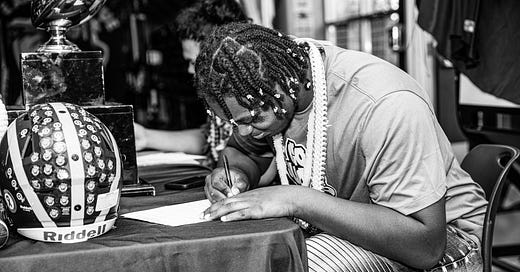How NIL is Changing Scholarship Opportunities for Student Athletes
Getting perspective from Scott Laigo, founder of Student Athlete Advocates.
This is not going to be one of those get-off-my-lawn moments where some middle-aged guy criticizes the business of college athletics for the pursuit of the almighty “bag.”
From the moment I first heard about collegiate athletes questioning why they didn’t get a cut from jerseys and merchandise being sold based on their numbers (sure, there weren’t names plates on those jerseys, but it was always clear who was represented). That struck me as unfair. In fact, when I was in high school, I had a No. 7 University of Washington jersey. I knew it was Brock Huard’s jersey, and when I found out that the athletes weren’t getting a portion of those proceeds, that didn’t seem right.
Ed O’Bannon had the right idea when he began his quest to fix this injustice. Now, though, the landscape feels like chaos — more business than sport. Just look at Bill Belichick. I was watching ESPN, and pundits were questioning how Belichick, now the coach at the University of North Carolina, would handle dealing with parents and sitting in the living rooms of players he was recruiting.
The truth is, he doesn’t have to deal with parents at all. He’s bringing an NFL coaching model to college, and with the portal, the Tar Heels will be competitive.
The College Football Gameday crew said as much earlier this week when discussing where the game is headed. Kirk Herbstreit asked the question on everyone’s mind:
“How’s it going to change? Who is going to make it change?”
Nick Saban’s response: “You have to have contracts.”
So, college football is headed toward a pro sports model that will require collective bargaining. That’s not necessarily a bad thing. However, it’s a change.
Right now, it’s chaos.
“I’m pretty sure, if you have kids, and you told your kids, ‘Mom and Dad are going out for the night, do whatever you want,’ you’re going to come back to chaos in the house,” said Scott Laigo, founder of Student Athlete Advocates. “Well, that’s exactly what we have now.”
Coaches aren’t spending as much time at high schools. They are talking to coaches they trust to get assessments of players in their areas. Similarly, local players who traditionally would have ended up at programs like Washington and Washington State are ending up at lower-tier schools to earn playing time before, hopefully, hitting the portal and landing on a bigger stage.
To help make sense of this new landscape, I invited Laigo to join me for the second episode of Spilled Ink.
“We are an educational platform,” Laigo said. “We’re not going to get your son or daughter a scholarship. If they’re 4-foot-1 and want to play center for UCLA, I can get you the information. Whether the coach calls, that’s a whole other story.”
Laigo gets real-time information based on what’s happening.
“My stepson is a college football coach at a Power 4 school, so I get a lot of insight into what’s really happening on the ground, and I try to provide that to parents, coaches, and athletic directors.”
The reality is, with the portal becoming more prevalent, there are fewer scholarship opportunities for high school athletes.
“The last three years, on average, there’s been about 525 fewer high school players taken at the Division I level, the Power 4 level,” Laigo said. “The portal has really changed that.”
The business of college football has never been more present. It’s impossible to simply look through glasses tinted in your alma mater’s colors.
The market — the pressure to win (and win big) now — sets a collegiate athlete’s value, which takes away some of the mystique of playing for a dream school.
My favorite part of working with Washington’s football program was the opportunity to get to know the players. I covered many of them as local high school athletes: Budda Baker, Kasen Williams, Danny Shelton, and on and on. And the athletes who came in from around the country were there long enough to become part of the culture.
Now you’ve got athletes like Penn State QB Beau Pribula entering the portal before his current team plays in the CFP. You can’t fault the athlete for making a business decision, but the system is a mess.
What does all of this mean for athletes who dream of earning a scholarship? If an athlete has an offer — a true opportunity where a coach is adamant there is a scholarship on the table — take it.
Note: If you’ve made it this far, thank you. Your support makes this work possible. If you are enjoying the content and want to see more, a subscription will help fund the work and provide an opportunity to spend more time on this project. I am truly grateful for everyone who has stopped by so far. Let’s grow this thing!




